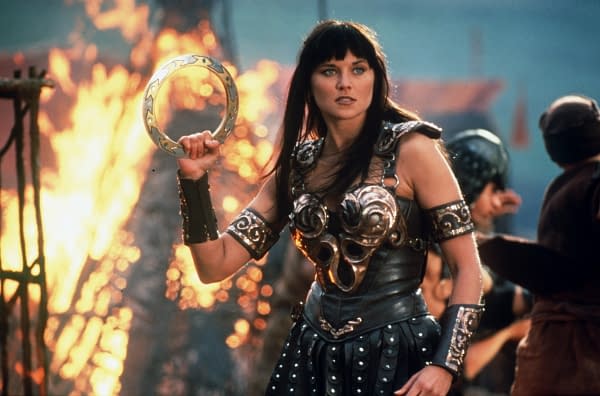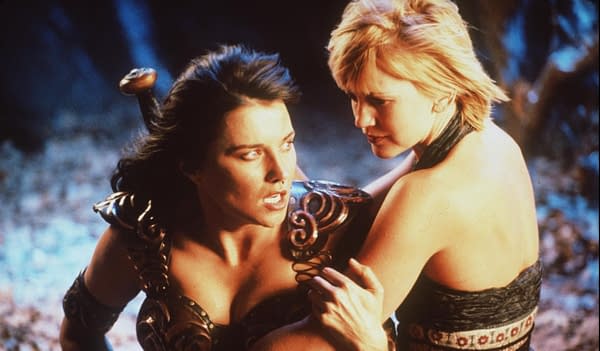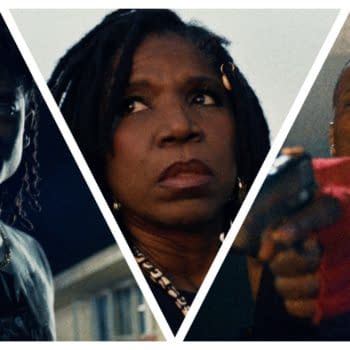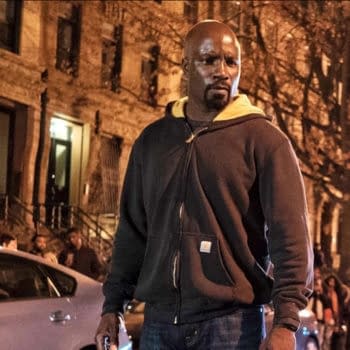Posted in: TV | Tagged: lucy lawless, Renée O'Connor, Steven L. Sears, xena, Xena: warrior princess
Xena: EP Steven Sears on Series Legacy of Shattering Conventions
Xena: Warrior Princess Writer/EP Steven L. Sears reflects on the fantasy series' legacy, LGBTQ overtones, the censors, fandom, and more.
As much has been said about Sam Raimi's legacy with Evil Dead and Spider-Man film franchises, it would be foolish to overlook what he built in the 1990s with the sword and sorcery/fantasy TV shows Hercules: The Legendary Series and its spinoff Xena: Warrior Princess. While both shows lasted six seasons, Xena has 23 more episodes and a more enduring legacy, breaking the mold of what's traditionally been a male-dominated genre with leads Lucy Lawless and Renée O'Connor, who play Xena and her traveling companion, Gabrielle, respectively. Both shows followed a similar theme of a hero and partner traveling throughout the ancient world fighting injustice from mortals and immortals alike, from warlords, tyrants, or anyone who dares to abuse their authority. Writer and executive producer Steven L. Sears spoke to The Guardian about how he distinguished Xena from Hercules, how Xena's drive for redemption for past atrocities, and how Gabrielle helps bring her balance and focus on their journey.

Xena: Warrior Princess EP on Pitch and Distinguishing Xena and Gabrielle
When Xena was pitched to an executive at Renaissance Pictures, the spinoff Sears described as "A hip, updated version of 'Hercules.'" When Lawless was a recurring cast member on Hercules, she turned the corner from being a villain to forge her new path to her series, which is an astonishing feat considering both series premiered in 1995, with Herc premiering in January and Xena in September.
"Building on Xena's backstory, we developed a character who has been turned into a feared warrior because of things that happened during her childhood and early adulthood, but at heart, she is a good person keen to help others," Sears said. "The common take was that she was on the path to redemption, but my belief was that she felt she could never redeem herself for the thousands she had killed."
Describing O'Connor's character, "Gabrielle, meanwhile, is a simple village girl given the chance to realize her dreams of adventure. Since she recorded the duo's escapades on scrolls, fans started calling her the battling bard," Sears said. "Right from the start, though, we refused to make her just a sidekick. She offered a beautiful, innocent perspective on Xena's darker, more barbaric character. Ultimately, she became Xena's savior."

The series' flexibility provided an eclectic mix of creative directions as Sears recalled co-creator Rob Tapert's "Wild ideas" like a musical episode and "leave us to make them work." As far as other ideas that the show had, "Later, we expanded our universe quite a bit. In one episode, clones of our heroes interacted with Xena fans in the present day. Another, set in an alternative reality, saw Xena ruling over the Roman empire with Karl Urban's Julius Caesar after their marriage. Xena offered the opportunity to go from drama one week to satire the next and, more importantly, had a cast and crew that could pull it off."
Sears takes issue with the genre the Lawless-starred series is put in. "People called Xena a sword and sorcery show, even though our universe had swords but no magic. There were mythological creatures and entities with powers, but those powers had restrictions. Most of the gods echoed the pettiness of mankind, with all their egos and desires." While the EP found the warrior princess to resonate broadly with demographics from children and students to older people, there was pushback with the suggested LGBTQ themes and what in the '90s was considered more risqué.
"Back then, the studio was very hesitant about suggesting Xena and Gabrielle were in a romantic relationship. They even objected to a moment in the title sequence where Xena is seen walking seductively towards the warlord Draco because he was shot from the back and had long hair, so could be mistaken for a woman," Sears recalled. "But as time went on, they decided to look the other way and just let us get on with it. Somebody once asked me if Xena and Gabrielle ever had sex. I said: 'It's none of my damn business. They do social and domestic duties together; they have fought for each other and died for each other. If you're defining the relationship just on sex, you're really missing the whole point.'"
For more on Sears's explanation of why they didn't want to box Gabrielle as a "damsel in distress" and how Lawless and O'Connor reacted to the series' fame and fanfare, make sure to check out the complete interview.

















